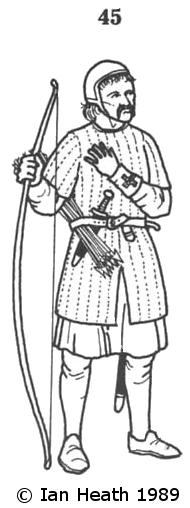
Try Amazon Audible Plus
ENGLISH INFANTRYMAN OF HENRY I'S REIGN
An extract from Armies of Feudal Europe 1066-1300by Ian Heath



45. ENGLISH INFANTRYMAN OF EDWARD I'S REIGN
By the time Henry III issued a new 'Assize of Arms' in 1242 (often misquoted as 1252) the bow had nominally become the principal weapon of most categories of English infantryman. However, though Henry raised 500 archers in the Weald in 1266 there are astonishingly few other references to archery during the civil war period of 1264-67, and evidence indicates that the bows in use at that time were still chiefly of the old 'short' variety (a bow discovered at Great Berkhampstead Castle, for instance, and tentatively dated to c. 1216, is only 4 feet in length). In fact the large-scale introduction of bow-armed troops and, more specifically, the longbow into English armies seems in reality to have taken place only in the late-13th century, as a direct result of Edward I's Welsh wars of 1277-95. Certainly spearmen also featured in Edward's Welsh and Scottish wars, but by the end of the century it is the bow that is specified in practically every instance in which arms are mentioned.
Henry III's Assize had required that all freemen with 40-100s. of land or 9-20 marks of chattels should serve with bow, arrows (number not specified but presumably 24, or perhaps 30) and sword, the former also having a dagger. Edward I's 'Statute of Winchester' of 1285 was merely a confirmation that these regulations still applied; the only change evident in an update of 1298 was that knights' horses were thenceforward to be barded. Freemen with less than 40s. or 9 marks of chattels were also expected to serve with a bow if they had one but had otherwise to make do with falces (probably fauchards), gisarmes, knives and other 'peasant' weapons. Quilted aketons or gambesons appear to have been generally worn (the Statute does not mention body-armour for men with less than 100s. of land, but an interim edict or 1230 specifies helmet and gambeson for men with 40s. in chattels). A call to arms of 1264 provides a list of arms which includes in addition spears, crossbows and swords, while the edict of 1230 gives the arms of the poorest category (those with only 20s. of chattels) as spear and axe.
Uniforms of a sort may now have been in existence too, a Norfolk contingent recorded in 1295 deriving their name 'Blaunchecotes' from the white tunics (gambesons?) with which they were issued, along with swords and knives, by the local authorities. Uniforms and recognition devices for militia contingents are also recorded on other occasions, the figure depicted here wearing over his leather bracer a cloth arm band marked with the red cross of St George, issued during Edward's Welsh wars; spearmen and cavalry substituted similarly marked lance-pennons. Amongst baronial contingents uniforms had appeared considerably earlier, certainty by the beginning of the 13th century, it being recorded in 1218 how a north country robber bought 100 marks' worth of cloth to outfit his following of 18 men 'as if he had been a baron or an earl'.